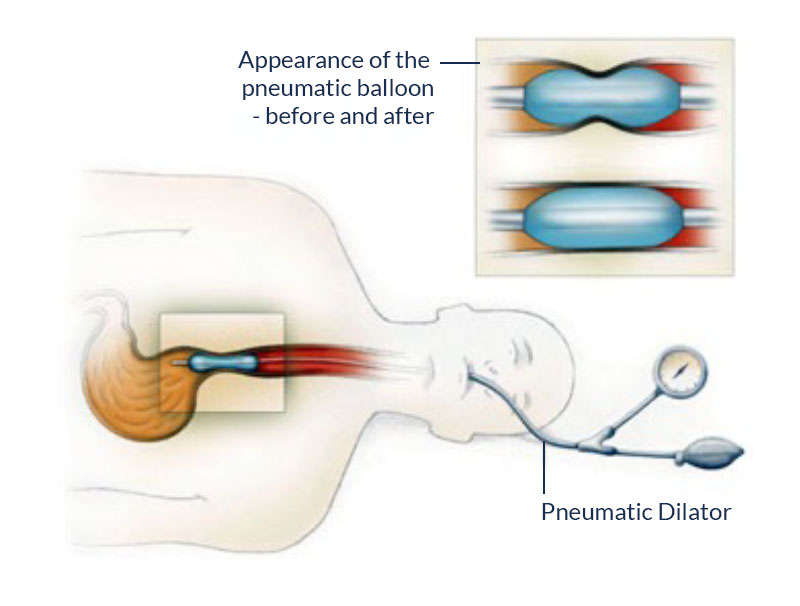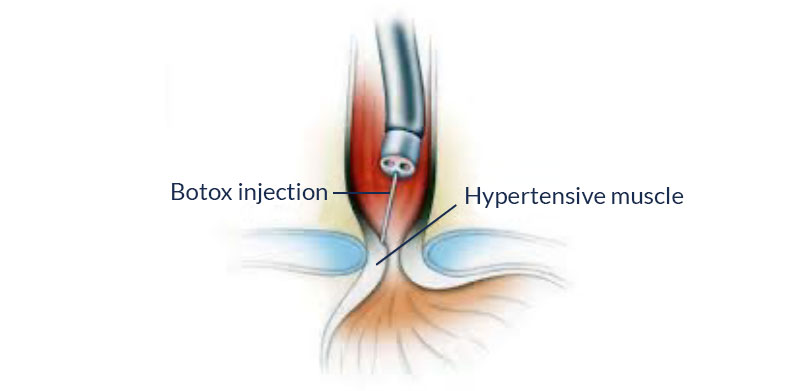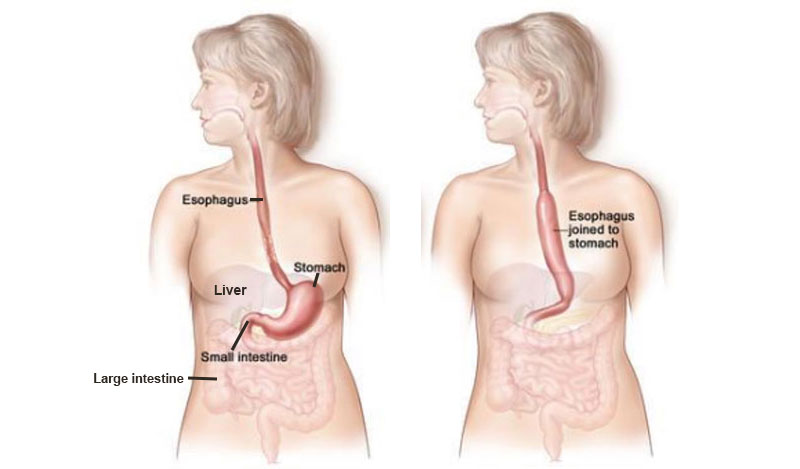"I began feeling that food was getting stuck when eating things such as almonds and oat biscuits"
How can Achalasia be treated?
Exploring treatment options for Achalasia
Treatments
Pneumatic Dilatation
Dilatation involves passing an endoscope through your throat with a balloon device attached to the equipment. The balloon is then inflated so that the lower oesophageal sphincter (LOS) is stretched. This is sometimes best done in two sessions about three or more weeks apart. Dilatation often results in at least some relief from symptoms and can bring significant improvement, but sometimes the benefits can be only short-term. The effect of a dilatation can make the tissue fibrous and less amenable to future procedures or surgery, so repeated dilatations sometimes have to be balanced against a potentially more definitive long-term treatment.

Dilatation (image courtesy of Memorial Hermann)
Heller Myotomy
This procedure was first performed in 1913 by surgeon Ernst Heller, using open surgery rather than modern laparoscopic (keyhole surgery) techniques. A laparoscopic Heller myotomy (LHM) consists of cutting the muscles in the lining of the oesophagus and stomach that control the lower oesophageal sphincter (LOS). Cutting the muscles reduces the compression of the LOS and allows it to remain permanently relaxed, thereby allowing food to move down into the stomach by gravity.
The length of the myotomy is an important issue for success of the procedure, and, in an adult, is typically about 10 cms in length, 3 cms of which would be in the stomach wall. A number of small incisions are made in your belly to allow access for the surgical instruments, but there is no conventional operation scar that would have been part of open surgery.
This surgery has been well established and often provides sustained benefits for the longer term. A trial conducted by Patti and others in the period 1991 – 1998 in California involved 168 patients, 29 of whom had an oesophagus with a diameter greater than 6 cms (2-3 cms is normal) . 90% of the patients had good or excellent results from the surgery.
Fundoplication and controlling reflux after Heller myotomy
Normally, the LOS acts as a valve to stop stomach acid refluxing up into the oesophagus. Prolonged exposure to stomach acid can cause heartburn and can also damage the lining of the oesophagus. To prevent this from happening after the myotomy, a fundoplication is carried out. The fundus is the top part of the stomach, and the procedure wraps the top part of the stomach round the bottom of the oesophagus to recreate the valve effect to control reflux.
There are various techniques for this, all of which depend on the circumstances of the individual patient. Sometimes the wrap is made around the back of the oesophagus; sometimes from the front. A Nissen fundoplication covers the full 360° circumference, Toupet 270°, Dor 180°-200°, and Watson 120°.
A partial rather than complete wrap is recommended by experienced surgeons. If the wrap is too tight it can cause too much restriction, and can affect your ability to vomit or belch. If there is a problem with the fundoplication wrap loosening over time, an experienced surgeon can sometimes revise the procedure.
Controlling reflux with medication
If reflux occurs after the surgery this can be controlled by PPI (proton pump inhibitor) medication like Omeprazole that is designed to reduce stomach acid. This medication is safe. There have been concerns expressed about the side effects of this medication when it is taken over a long period, such as potential issues relating to osteoporosis and the effects on gut bacteria, but these would be unlikely to be factors in the short term compared to the benefit of relief from the reflux symptoms.
It is generally prudent to ask your GP for a review of medication that you have been taking on a long-term basis so that any alternatives can be considered.
POEM
POEM (per oral endoscopic myotomy) is a relatively new procedure that is performed with an endoscope passed down into the oesophagus through your mouth under sedation or general anaesthetic. This procedure does not require incisions to be made in your belly for the laparoscopic instruments used for a Heller myotomy. The procedure may be performed by either gastroenterologists or surgeons. The endoscope is used to make a cut in the lining of the oesophagus from the inside, and the instrument is then passed through the interior wall of the oesophagus and the stomach to sever the same muscles as would have been cut in a Heller myotomy.

Endoscope entering the lining of oesophagus (POEM)
©Inoue H. Showa University Northern Yokohama, 2010
This procedure does not involve a fundoplication wrap to recreate the LOS valve effect against reflux. If acid reflux occurs afterwards, PPI medication may be required. There may be some specific situations where POEM may be a preferable technique compared to a Heller myotomy. Previous botox or dilatations may make the tissue more fibrous and may sometimes prevent the endoscope from reaching the full distance desirable for a full POEM procedure. It is sometimes possible for a POEM to be repeated using a different part of the oesophageal lining. As with many medical procedures, the experience of the medical practitioner involved is an important factor in success rates.
Medication
Although not regarded as standard treatment as such, calcium channel blockers can be used to reduce hypertension and reduce blood pressure. Nitrates can relax muscles in the LOS within a few minutes.
Generally there tends to be an initial improvement in 50%-90% of cases, but 30% of patients have some form of side-effects. This approach may sometimes be used as a temporary bridge pending other treatment.
Read more on Medication here
Botox
Botulin toxin injections (Botox) into the LOS take three or four minutes and can reduce the muscle tone in the LOS, decrease LOS pressure and improve the flow of food into the stomach, but the relapse rate within three months is about 50%, so there are reduced chances of this having sustained benefits. It can be a useful approach for when surgical options are limited, but this option is regarded as suitable only for those unable to tolerate more definitive therapies.

Botox injection (image courtesy of Memorial Hermann)
Oesophagectomy
Very much at the extreme end of experience and a last resort for people with achalasia, an oesophagectomy involves removal of the oesophagus. The top of the stomach is then drawn up into the chest and joined to the remainder of the oesophagus below the throat. This surgery is a major operation with consequences for the digestive system like having to eat little and often, and having to avoid sugary food that might create insulin spikes. Patients can achieve a reasonably good quality of life after this surgery. Those facing the prospect of this surgery would normally discuss with a specialist surgeon a number of factors. These may include the prospect of relieving the severe loss of quality of life that end-stage achalasia can bring, whether they have other medical conditions, the risk of undigested food being aspirated into their lungs, potential general malnutrition, and their level of fitness to cope with a significant period of recuperation after the surgery.

Diagram of oesophagectomy © Terese Winslow; St Francis Care
Further Reading
Where to Find Treatment
It is important that you are treated by somebody who has a good level of experience with this rare condition.
Initial referrals will most often be to a gastroenterologist. Sometimes gastroenterologists will undertake the treatment, but it is also the case that some cases will be undertaken by specialist surgeons.
It is best to be at a centre where there is close collaboration between gastroenterologists and surgeons so that the proposed treatment can be tailored well to the individual needs as a patient.
Making decisions about treatment
Achalasia is a long-term condition that does not have a definitive cure, so decisions about what treatment to undertake need to be long-term, and should be discussed carefully with your medical practitioner. The best option is to consult an experienced doctor at a specialist centre that offers a full range of treatments that can be tailored to suit the individual patient.
Despite an understandable reluctance about more complex procedures, the risks and the benefits should always be balanced against each other – temporary discomfort following a 1 or 2-hour procedure and several days of recovery against the more than 80% likelihood of significant improvement in symptoms. To some extent it is easier to try the simpler procedures (eg dilatation) first but these treatments may not provide sustained relief and additional treatments may be required later. Myotomy frequently improves matters, and often makes a dramatic difference.
Lifestyle changes, particularly reduction of stress and anxiety, can improve symptoms. Achalasia will rarely improve by itself over time, however, and may well deteriorate if untreated. There are also potential issues with ulcers being formed with prolonged exposure to undigested food remaining in the oesophagus, so it is best to make decisions for the long term, and opt for treatment that will likely provide the best long-lasting benefits.
Experiences of achalasia vary considerably. Some people with achalasia have mild symptoms for a long period of time, and do not have any surgical procedures. Sometimes it is difficult with a rare condition to assess how it will develop, and the advice of an experienced specialist medical practitioner becomes invaluable.
What to expect from treatment
Many people with achalasia have a poor quality of life around food and will also be experiencing the effects of food obstruction, regurgitation and aspirating undigested food into their lungs.
After treatment, better digestion will normally be achieved largely because the obstruction in the digestive tract has been removed so that gravity will cause food to make progress into the stomach. This will enable better nutrition and reduce much of the anxiety associated with eating. Spasms may not be completely resolved after a myotomy because the effect on the nerve system can be unpredictable.
It will probably still be necessary to be careful about eating, to avoid rushing meals, to keep an upright posture, to avoid some foods, and to avoid eating late in the evening. Trying to remove stress, tension and anxiety will always have a beneficial effect: the surgery will not allow you to completely ignore that aspect of a busy lifestyle. So you will probably not be able to ‘rush’ eating again as you once might have done before you had achalasia!
After treatment you will be given instructions about having ‘sloppy’ or ‘mushy’ food including soup for a period, and you should then be able gradually to progress to more solid food. Your nutrition and energy levels will probably improve significantly and you should be able to resume many pleasurable aspects of life that might have been denied to you by achalasia.
FAQs
Risks
Helping you understand the risks associated with treatment
Meeting Forums
Need help? Call the helpline on 0300 772 7795 or email admin@achalasia-action.org
Need help?
Call the helpline on 0300 772 7795
or email
admin@achalasia-action.org
Relaxation, complementary therapies and stress management
Stress and tension can have an adverse effect on making swallowing more difficult for people with achalasia, and this can apply both before and after medical treatment for the condition. Coping with achalasia can also be a challenge from a mental health perspective.
Sometimes there is little evidence in the form of medical trials on which recommendations can be based in relation to different approaches and techniques, but on the basis that some people have found them helpful, it can be justified to give them a try carefully if you feel drawn towards a particular approach, but not to hesitate to withdraw from the treatment after a few sessions if you feel that no benefit is being achieved.
Some complementary therapists have voluntary registers (some of which are accredited by the Professional Standards Authority for Health and Social Care, or the PSA) or professional associations that practitioners can join if they choose.
Some of the approaches are listed on this website but do not amount to a recommendation for any individual, or generally. They are intended merely to give more information and to signpost where more detail is available.

Acupuncture and Acupressure
Acupuncture originated from ancient Chinese medicine and involves fine needles being inserted at certain points in the body for therapeutic or preventive purposes. It is sometimes used in some NHS GP practices, in pain clinics and in hospices in the UK, but clinicians may be unwilling to refer people for acupuncture on the basis of insufficient data from medical trials.
One experiment with medical students established that pain in the oesophagus was reduced when the person’s foot was plunged into cold water, thereby indicating that a beneficial effect could be achieved through the nervous system.
Acupressure involves pressure being applied to certain points of the body rather than needles being inserted.
Hypnotherapy
Hypnotherapy is not available on the NHS but can be used to treat some conditions or to change habits. The therapist will discuss what methods will be used and may lead you into a deep, relaxed state, after which most people feel relaxed and refreshed. In the UK, there is no law to oblige hypnotherapists to have specific training. The NHS website advises that people should seek a hypnotherapist who has a medical background.
Reflexology
Reflexology is used by some people who find it generally relaxing and helpful to alleviate stress. The theory is that pressure applied to areas of the feet correspond to certain organs and systems of the body. Foot charts are used so that pressure is applied to certain parts of the feet. It is sometimes combined with other hands-on therapies and may be offered by chiropractors and physical therapists, among others.
Research evidence about reflexology is sparse. It is not widely available on the NHS but is sometimes used to help cancer patients, for instance, relax.
Mindfulness
Some people are attracted to mindfulness on the basis that being more aware of our surroundings helps our mental well-being and may help to deal with stress and anxiety. The NHS website describes mindfulness in more detail.
Yoga
Yoga concentrates on strength, flexibility and breathing to boost physical and mental health, and it is said that there is some evidence that it can help people with stress, depression, high blood pressure and aches and pains.
Tai Chi and Benefits of Exercise
Tai Chi, also known as Tai Chi Chuan, combines deep breathing and flowing movements. It originated as a martial art in China, but is now appreciated around the world as a health-promotion activity.
The NHS website contains advice on exercise as a more general topic that can benefit health